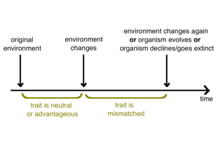Evolutionary mismatch (also "mismatch theory" or "evolutionary trap") is the evolutionary biology concept that a previously advantageous trait may become maladaptive due to change in the environment, especially when change is rapid. It is said this can take place in humans as well as other animals.

Environmental change leading to evolutionary mismatch can be broken down into two major categories: temporal (change of the existing environment over time, e.g. a climate change) or spatial (placing organisms into a new environment, e.g. a population migrating).[1] Since environmental change occurs naturally and constantly, there will certainly be examples of evolutionary mismatch over time. However, because large-scale natural environmental change – like a natural disaster – is often rare, it is less often observed. Another more prevalent kind of environmental change is anthropogenic (human-caused). In recent times, humans have had a large, rapid, and trackable impact on the environment, thus creating scenarios where it is easier to observe evolutionary mismatch.[2]
Because of the mechanism of evolution by natural selection, the environment ("nature") determines ("selects") which traits will persist in a population. Therefore, there will be a gradual weeding out of disadvantageous traits over several generations as the population becomes more adapted to its environment. Any significant change in a population's traits that cannot be attributed to other factors (such as genetic drift and mutation) will be responsive to a change in that population's environment; in other words, natural selection is inherently reactive.[3] Shortly following an environmental change, traits that evolved in the previous environment, whether they were advantageous or neutral, are persistent for several generations in the new environment. Because evolution is gradual and environmental changes often occur very quickly on a geological scale, there is always a period of "catching-up" as the population evolves to become adapted to the environment. It is this temporary period of "disequilibrium" that is referred to as mismatch.[1] Mismatched traits are ultimately addressed in one of several possible ways: the organism may evolve such that the maladaptive trait is no longer expressed, the organism may decline and/or become extinct as a result of the disadvantageous trait, or the environment may change such that the trait is no longer selected against.[1]
- ^ a b c Lloyd, Elisabeth; Wilson, David Sloan; Sober, Elliott (2011). "Evolutionary Mismatch And What To Do About It: A Basic Tutorial". Evolutionary Applications: 2–4.
- ^ Lean, Judith L.; Rind, David H. (2008). "How Natural and Anthropogenic Influences Alter Global and Regional Surface Temperatures: 1889 to 2006". Geophysical Research Letters. 35 (18) (published 16 September 2008): L18701. Bibcode:2008GeoRL..3518701L. doi:10.1029/2008GL034864.
- ^ Connallon, Tim; Clark, Andrew G. (2015). "The Distribution Of Fitness Effects In An Uncertain World". Evolution. 69 (6): 1610–1618. doi:10.1111/evo.12673. PMC 4716676. PMID 25913128.